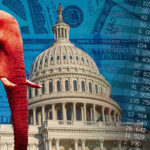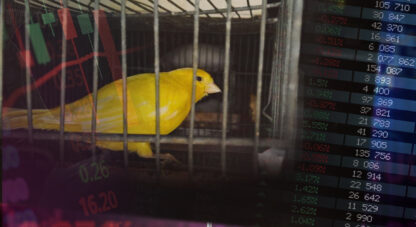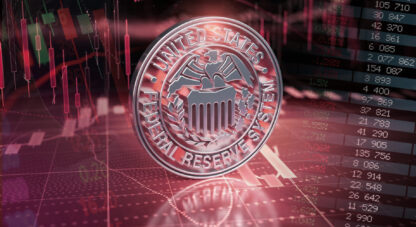Please join Doug Noland and David McAlvany this Thursday, October 18th at 4:00PM EST/ 2:00pm MST for the Tactical Short Q3 recap conference call, “Market Contagion is Back.” Click here to register.
There’s little satisfaction writing the CBB after a big down week in the markets. Motivation seems easier to come by after up weeks, perhaps my defiant streak kicking in. I find myself especially melancholy at the end of this week. There’s a Rude Awakening Coming – perhaps it’s finally starting to unfold.
Many will compare this week’s market downdraft to the bout of market tumult back in early-February. At the time, I likened the blowup of some short volatility products to the June 2017 failure of two Bear Stearns structured Credit funds – an episode marking the beginning of the end for subprime and the greater mortgage finance Bubble. First cracks in vulnerable Bubbles. Back in 2007, it took 15 months for the initial fissure to develop into the “worst financial crisis since the Great Depression.”
I posited some months back that tumult in the emerging markets marked the second phase of unfolding Crisis Dynamics. I have argued that the global government finance Bubble, history’s greatest Bubble, has been pierced at the “periphery.” More recently, the analytical focus has been on “Periphery to Core Crisis Dynamics.” I’ve chronicled de-risking/deleveraging dynamics making headway toward the “Core.” This week the “Core” became fully enveloped, as the unfolding global crisis entered a critical third phase.
Today’s backdrop is altogether different than that of February. For one, back then “money” was flowing readily into the emerging markets – too much of it “hot money.” “Risk on” was still dominant early in the year. Speculative leverage was expanding, with resulting liquidity abundance on an unprecedented global scale. With such a powerful global liquidity backdrop, a fleeting dislocation in U.S. equities proved no impediment to the hard-charging U.S. bull market. Indeed, global liquidity rushed into U.S. securities markets, fueling powerful speculation blow-off dynamics.
February market instability did, however, mark a key inflection point for risk embracement at the “Periphery.” And the combination of acutely vulnerable Bubbles at the “Periphery” and blow-off dynamics at the “Core” proved highly destabilizing. The dollar rally helped push EM currencies over the cliff, while booming markets and economic activity in the U.S. pressured both the Fed and market yields. The upshot was a rather abrupt tightening of financial conditions for the emerging markets that, ironically, spurred a dangerous late-cycle Terminal Phase of speculative excess and resulting loose financial conditions in the U.S.
In stark contrast to February’s robust financial conditions, the global liquidity backdrop these days is acutely fragile. Rather than the risk embracement environment from early in the year, risk aversion holds sway. On a global basis, speculative dynamics are dominated by de-risking and deleveraging. Liquidity is being destroyed instead of created, and it is anything but clear in my mind how the unfolding tightening of financial conditions would be reversed.
It is not only the speculative backdrop that has experienced momentous change. The Fed has liquidated about $250bn of its holdings since February. Both the ECB and BOJ have significantly reduced monthly QE liquidity injections from earlier in the year. The Fed has increased rates three times for a total of 75 bps. Rates were hiked to 60% in Argentina and 24% in Turkey. Throughout the emerging markets, central banks have been raising rates.
Global bond yields are much higher than in early-February. Argentine 10-year yields have surged 360 bps to 9.66%. Yields are up 685 bps in Turkey (21.1%), 340 bps in Pakistan (11.56%), 326 bps in Lebanon, 250 bps in Indonesia, 157 bps in Russia, 152 bps in Hungary, 114 bps in Brazil, 112 bps in Philippines, 105 bps in Peru, 82 bps in South Africa, 72 bps in Colombia and 56 bps in Mexico. And these are sovereign yields. Corporate debt has performed even worse, with notable weakness in Asian high-yield and dollar-denominated corporates more generally. And it’s not as if European finance is sound. Italian 10-year yields have jumped 160 bps to 3.58%. This ongoing spike in global yields has certainly placed intense pressure on leveraged speculation.
Here at home, after trading as high as 3.26% in Monday’s session, 10-year Treasury yields ended the week down seven bps to 3.16%. Yields were at 2.84% on February 2nd and then dropped to 2.71% during a tumultuous day for equities on February 5th. WTI crude traded down to $55 in February.
The Bloomberg Barclays US Corporate High Yield index began February at 5.78%, jumped to 6.36% by February 9th and then dropped back below 6.00% in April. And after reaching 6.54% in early July, yields declined to as low as 6.17% last Tuesday (10/2). This index saw yields surge 22 bps this week to 6.63%, the high going back to 2016.
It’s my view that enormous leverage has accumulated throughout U.S. corporate Credit over this prolonged period of easy “money.” It appears “Risk Off” dynamics attained important momentum in the U.S. corporate debt market this week.
October 12 – Bloomberg (Cecile Gutscher): “Nervous money managers fled from corporate bonds like never before in an exodus that outpaced stocks. Record outflows hit funds that buy investment-grade debt…, according to Bank of America Corp. strategists citing EPFR Global data. The redemptions totaled $7.5 billion in the week through Oct. 10. By comparison, investors pulled $1.4 billion from equity portfolios during the period, while government and Treasuries actually saw inflows… High-grade bond gauges have also suffered the steepest losses of all the Bloomberg Barclays indexes in this month’s market meltdown.”
As is generally the case, news and analysis follow market direction. With the market breaking to the downside, attention turns to the Federal Reserve and the unfolding trade war with China. Last Wednesday, with the market at record highs, pundits were celebrating the robust U.S. economy. What a difference a week makes.
I’ve received numerous emails over recent months questioning the supportive comments I’ve directed at Chairman Powell. This historic Bubble inflated throughout the watches of Drs. Greenspan, Bernanke and Yellen. Powell will surely be the scapegoat when things fall apart. The President has wasted no time in pointing fingers. It has to be the first time a central bank has been lambasted for gradually raising rates to a loco 2.25%.
October 10 – Bloomberg (Justin Sink and Shannon Pettypiece): “President Donald Trump slammed the Federal Reserve as ‘going loco’ for its interest-rate increases this year in comments hours after the worst U.S. stock market sell-off since February. Trump said… the market plunge wasn’t because of his trade conflict with China: ‘That wasn’t it. The problem I have is with the Fed,’ he said. ‘The Fed is going wild. They’re raising interest rates and it’s ridiculous.’ ‘That’s not the problem,’ he said of the trade standoff. ‘The problem in my opinion is the Fed,’ he added. ‘The Fed is going loco.’ His latest criticism of the central bank began earlier Wednesday as he arrived in Pennsylvania for a campaign rally. ‘They’re so tight. I think the Fed has gone crazy,’ the president said.”
We’re now, in real time, witnessing the inevitable dilemma created when a central bank falls “behind the curve.” And keep in mind that rising asset prices are contemporary finance’s prevailing type of inflation (inflationary manifestation). Leaving rates so low for such a long period of time was responsible for inflating myriad major Bubbles. And now central bankers face the high-risk proposition of normalizing rates in an acutely fragile Bubble backdrop. The bulls, of course, believe it would be reckless for a central bank not to reduce rates when the markets find themselves in a bit of trouble. Continuing to raise rates would be gross negligence; a show of total incompetence; and so on. President Trump wants to pin blame on Fed rate hikes, seemingly with no recollection of the “big fat ugly Bubble” he would herald on the campaign trail.
I’ll assume that short rates will be heading back to zero – and that more QE will be forthcoming. But that’s of little help for today’s increasingly illiquid markets. Markets in the near-term have a problem: central bankers are not at the edge of their seats fretting a market meltdown. Dr. Bernanke had a persistently weak stomach, fearful his entire monetary experiment would come crashing down upon him at any time. Markets were similarly confident that a risk averse chair Yellen wouldn’t dare try anything that might put global markets at risk.
So inflating Bubbles were left to run wild, market participants ever confident that the greater Bubbles inflated the more averse central bankers would be to removing the punchbowl. Monetary madness stretched out for way too long. The job of returning central banking to some semblance of normality is left to Chairman Powell. It’s a thankless job; winless. It is deeply unfair – and I would argue disturbing – to see him setup to be the villain. I believe deeply that monetary inflation is the enemy of the people. Responsible central banking is not.
It would not be surprising if the Fed Chairman and central bankers, more generally, are not at this point overly concerned with the current bout of market instability. After all, markets have over recent years taken these types of selloffs in stride, “buying opportunities” as markets quickly bounced back to ever-higher new records. Besides, aren’t speculative markets overdue for a wakeup call? Markets fear that central bankers lack fear.
Hedging and option-related selling surely played a significant role in this week’s downdraft. And with expiration next Friday, expect option-related trading to play a major role well into next week – either on the upside or down. Repeatedly we’ve seen expiration-week rallies destroy put value. If market strength does force a self-reinforcing reversal of hedges into expiration, the bulls will see the rally as evidence of a market on sound footing (the week was notable for the amount of bullish pontification in the face of an unbullish market reality).
But don’t be fooled by fleeting option-related buy programs and the appearance of abundant liquidity. The backdrop is changing. Importantly, de-risking/deleveraging dynamics have arrived at the “Core.” They have not only made it to the “Core,” they’ve afflicted a vulnerable “Core” in a global backdrop of waning central bank liquidity, rising short-term rates and surging market yields.
“Risk Off” has become a global phenomenon – de-risking/deleveraging within a backdrop of central banks hoping to move beyond years of repeated market liquidity backstop operations. Moreover, it is a backdrop of highly divisive politics and troubling geopolitics. It is a worrying backdrop of escalating populism, nationalism and protectionism – that will matter now that markets are faltering.
I tell my wife that “it’s over” just to hear her laugh. “How many times have you said that?,” she’ll say. With a chuckle, I respond, “This time I mean it.” We shared a little laugh together, but this time I wasn’t kidding. I do vividly recall thinking “it’s over” in the summer of 2012, not anticipating that the Germans would tolerate Draghi’s “whatever it takes” unlimited “money” printing operations. And I similarly recall thinking “it’s over” with China’s Bubble at the precipice in early-2016. I guess I should have anticipated China’s “national team,” along with a ratcheting up of QE from the BOJ and ECB and an abrupt postponement of Fed “normalization” (after one tiny baby step).
I think “It’s over” because all these market bailouts ensured things turned really crazy – and I believe this time around it’s going to take central bankers longer to respond. I sense little appetite for another round of concerted global “money” printing operations. The focus is on domestic issues rather than some global agenda.
And market structure has become acutely vulnerable. Trillions in perceived safe and liquid ETFs. Trillions in a hedge fund industry struggling with performance and susceptible to huge outflows. Hundreds of Trillions of derivatives susceptible to market dislocation and illiquidity. Too much derivative market “insurance” that risks fomenting an avalanche of self-feeding sell orders. And let’s not forget the maladjusted U.S. economic structure that will function surprisingly poorly in a backdrop of tighter financial conditions and sinking securities markets.
In particular, it was an ominous week for the two great intertwined Bubbles, illustrated by the Shanghai Composite’s and S&P500’s respective 7.6% and 4.1% declines. I could go on and on, but I find it all sad and frustrating.
For the Week:
The S&P500 dropped 4.1% (up 3.5% y-t-d), and the Dow fell 4.2% (up 2.5%). The Utilities declined 1.3% (unchanged). The Banks sank 5.7% (down 5.8%), and the Broker/Dealers fell 5.4% (down 1.9%). The Transports sank 6.4% (down 1.2%). The S&P 400 Midcaps dropped 4.9% (down 1.5%), and the small cap Russell 2000 sank 5.2% (up 0.7%). The Nasdaq100 declined 3.3% (up 11.9%). The Semiconductors dropped 4.7% (unchanged). The Biotechs lost 5.0% (up 16.4%). With bullion rallying $15, the HUI gold index jumped 6.9% (down 20.3%).
Three-month Treasury bill rates ended the week at 2.22%. Two-year government yields slipped three bps to 2.85% (up 97bps y-t-d). Five-year T-note yields declined six bps to 3.01% (up 81bps). Ten-year Treasury yields fell seven bps to 3.16% (up 76bps). Long bond yields declined seven bps to 3.33% (up 59bps). Benchmark Fannie Mae MBS yields declined five bps to 3.96% (up 104bps).
Greek 10-year yields dropped 10 bps to 4.38% (up 31bps y-t-d). Ten-year Portuguese yields rose 10 bps to 2.04% (up 10bps). Italian 10-year yields jumped 15 bps to 3.58% (up 156bps). Spain’s 10-year yields rose 10 bps to 1.67% (up 11bps). German bund yields dropped eight bps to 0.50% (up 7bps). French yields declined four bps to 0.87% (up 8bps). The French to German 10-year bond spread widened four bps to 37 bps. U.K. 10-year gilt yields fell nine bps to 1.63% (up 44bps). U.K.’s FTSE equities index sank 4.4% (down 9.0%).
Japan’s Nikkei 225 equities index sank 4.6% (down 0.3% y-t-d). Japanese 10-year “JGB” yields slipped less than a basis point to 0.15% (up 10bps). France’s CAC40 lost 4.9% (down 4.1%). The German DAX equities index sank 4.9% (down 10.8%). Spain’s IBEX 35 equities index fell 3.8% (down 11.4%). Italy’s FTSE MIB index sank 5.4% (down 11.9%). EM equities were mostly lower. Brazil’s Bovespa index added 0.7% (up 8.5%), while Mexico’s Bolsa declined 1.3% (down 3.9%). South Korea’s Kospi index dropped 4.7% (down 12.4%). India’s Sensex equities index gained 1.0% (up 2.0%). China’s Shanghai Exchange sank 7.6% (down 21.2%). Turkey’s Borsa Istanbul National 100 index rallied 1.9% (down 16.2%). Russia’s MICEX equities index declined 2.0% (up 13.9%).
Investment-grade bond funds saw outflows of $360 million, and junk bond funds suffered outflows of $4.928 billion (from Lipper).
Freddie Mac 30-year fixed mortgage rates surged 19 bps to 4.90% (up 99bps y-o-y). Fifteen-year rates rose 14 bps to 4.29% (up 108bps). Five-year hybrid ARM rates gained six bps to 4.07% (up 91bps). Bankrate’s survey of jumbo mortgage borrowing costs had 30-yr fixed rates up ten bps to 4.88% (up 70bps).
Federal Reserve Credit last week declined $8.8bn to $4.137 TN. Over the past year, Fed Credit contracted $282bn, or 6.4%. Fed Credit inflated $1.326 TN, or 47%, over the past 310 weeks. Elsewhere, Fed holdings for foreign owners of Treasury, Agency Debt rose $8.3bn last week to $3.444 TN. “Custody holdings” were up $83.9bn y-o-y, or 2.5%.
M2 (narrow) “money” supply jumped $19.6bn last week to a record $14.286 TN. “Narrow money” gained $557bn, or 4.1%, over the past year. For the week, Currency increased $1.9bn. Total Checkable Deposits dropped $24.5bn, while Savings Deposits jumped $37.7bn. Small Time Deposits added $1.5bn. Retail Money Funds gained $2.9bn.
Total money market fund assets gained $16.1bn to an eight-year high $2.888 TN. Money Funds gained $147bn y-o-y, or 5.4%.
Total Commercial Paper added $1.8bn to $1.102 TN. CP gained $38bn y-o-y, or 3.6%.
Currency Watch:
October 9 – Wall Street Journal (Saumya Vaishampayan and Mike Bird): “China’s effort to support its slowing economy is heaping pressure on the yuan, signaling challenges for Beijing as it tries to stimulate growth amid rising trade tensions without triggering destabilizing capital outflows. The yuan weakened beyond 6.93 per dollar this week, coming within striking distance of its lowest level since January 2017, after China moved over the weekend to free more funds for domestic banks… Interbank lending rates in Hong Kong-an offshore trading hub for the yuan-surged on Tuesday, possibly due to efforts by China’s central bank to prevent the yuan from weakening too much, several analysts said. China’s efforts to manage its currency are complicated by the escalating trade conflict between the U.S. and China…”
The U.S. dollar index slipped 0.4% to 95.258 (up 3.4% y-t-d). For the week on the upside, the South African rand increased 1.7%, the Brazilian real 1.5%, the Japanese yen 1.4%, the Swedish krona 1.2%, the Norwegian krone 1.0%, the New Zealand dollar 1.0%, the Australian dollar 0.9%, the euro 0.3%, the Singapore dollar 0.3% and the British pound 0.3%. For the week on the downside, the Canadian dollar declined 0.7%, the Mexican peso 0.2%, the Swiss franc 0.1% and the South Korean won 0.1%. The offshore Chinese renminbi declined 0.77% versus the dollar this week (down 6.00% y-t-d).
Commodities Watch:
The Goldman Sachs Commodities Index dropped 3.2% (up 8.2% y-t-d). Spot Gold rallied 1.2% to $1,218 (down 6.5%). Silver was little changed at $14.63 (down 14.7%). Crude gave back $2.83 to $71.51 (up 18%). Gasoline sank 6.6% (up 8%), while Natural Gas was little changed (up 6%). Copper gained 1.8% (down 15%). Wheat slipped 0.7% (up 21%). Corn gained 1.5% (up 7%).
Market Dislocation Watch:
October 10 – Bloomberg (Andrew Mayeda and Saleha Mohsin): “Global finance chiefs played down the economic risks posed by the biggest U.S. stock sell-off since February, with many describing the decline as a long-awaited correction. ‘The fundamentals of the U.S. economy continue to be extremely strong, I think that’s why the stock market has performed as well as it has,’ U.S. Treasury Secretary Steven Mnuchin told Bloomberg News at the IMF’s annual meeting… ‘The fact that there’s somewhat of a correction given how much the market has gone up is not particularly surprising.’”
October 10 – Wall Street Journal (Editorial Board): “Ten years after the financial panic, the architects of the rescue policies are taking a victory lap. We won’t relitigate the immediate panic response, some of which we supported. But there is one policy whose outcome is still uncertain: The Federal Reserve’s near-decade of unprecedented zero-interest rates and bond buying. Is the October correction in stocks, including Wednesday’s 3% plunge, telling us that this bill is now coming due? The final payments on any Fed monetary cycle aren’t merely the results when interest rates are low and policy is easy. The verdict is clear only at the end of the cycle when the Fed has to unwind its accommodation and interest rates rise. Only then can the world see clearly whether the Fed overdid its stimulus with nasty consequences on the other end.”
October 10 – Bloomberg (Gowri Gurumurthy): “Junk-bond investors are getting nervous as the financial markets sell-off spreads. Investors pulled $5.4 billion of cash out of high-yield bond funds from Oct. 4 through Tuesday, JPMorgan… wrote…, citing Lipper data. That’s the biggest outflow for a similar period since a $6.3 billion drawdown in February, the second largest on record, according to the report. Exchange-traded funds led the drain…”
Trump Administration Watch:
October 11 – Bloomberg (Jennifer Jacobs and Toluse Olorunnipa): “President Donald Trump said he won’t fire Federal Reserve Chairman Jerome Powell but blamed an ‘out of control’ U.S. central bank for the worst stock market sell-off since February. Trump also told reporters in the Oval Office Thursday morning that he knows monetary policy better than the Fed’s leaders and continued criticizing them for interest-rate increases. ‘The Fed is out of control,’ Trump said. ‘I think what they’re doing is wrong.’ The president added that the Fed’s interest rate increases are ‘not necessary in my opinion and I think I know about it better than they do.’ Trump’s criticisms mark a stunning departure from the practices of his recent predecessors.”
October 12 – Reuters (David Lawder): “U.S. Treasury Secretary Steven Mnuchin said… that he told China’s central bank chief that currency issues need to be part of any further U.S.-China trade talks and expressed his concerns about the yuan’s recent weakness. Mnuchin also told Reuters in an interview that China needs to identify concrete ‘action items’ to rebalance the two countries’ trade relationship before talks to resolve their disputes can resume.”
October 12 – Reuters: “China’s trade surplus with the United States surged to a record high of $34.13 billion in September, compared with $31.05 billion in August… The September surplus with the U.S. was larger than China’s overall trade surplus of $31.69 billion for the month.”
October 9 – Reuters (Roberta Rampton and Lisa Lambert): “President Donald Trump… repeated his threat to slap tariffs on an additional $267 billion of Chinese imports if Beijing retaliates for the recent levies and other measures the United States has imposed in an escalating trade war between the economic giants. Trump, speaking to reporters in the Oval Office, also said China is not ready to reach a deal on trade. ‘China wants to make a deal, and I say they’re not ready yet,’ Trump said. ‘I just say they’re not ready yet. And we’ve canceled a couple of meetings because I say they’re not ready to make a deal.’”
October 8 – Financial Times (Tom Mitchell and Lucy Hornby): “US officials have warned China that Donald Trump will not engage in trade talks with Xi Jinping at next month’s G20 summit if Beijing does not produce a detailed list of concessions, according to three people briefed on negotiations… The Chinese, however, say they have such a list but would not present it without some guarantee of it being received in a stable political climate in Washington, including a point person with a mandate to negotiate on behalf of the Trump administration… US officials have been frustrated by what they see as Beijing’s unwillingness to discuss substantive ‘structural issues’ related to its economic and trade policies. Beijing has been similarly irritated by the erratic approach of the Trump administration…”
October 6 – Wall Street Journal (Bob Davis): “While the White House is progressing on trade deals with allies including Canada, Mexico, Korea and Europe, its dispute with China looks increasingly intractable, with tariffs between the world’s two largest economies likely cemented in place for years. In other trade fights, President Trump used tariffs as leverage to reach deals. Threatening car tariffs helped convince Canada and Mexico to concede to U.S. demands for a new North American Free Trade Agreement, the president boasted. ‘Without tariffs, we wouldn’t be talking about a deal,’ he said… China is different. Tariffs aren’t simply a negotiating tactic for the U.S., but a way to change economic incentives. The Trump trade team believes U.S. firms need protection from a predatory Chinese state, which Mr. Trump says coerces U.S. companies to fork over technologies and subsidizes Chinese firms to expand globally.”
October 10 – CNBC (Tae Kim): “Treasury Secretary Steven Mnuchin has told China not to weaken its currency as the U.S. and China try to resolve their trade differences. Mnuchin told the Financial Times the Treasury Department is closely watching the currency market and wants to talk about the issue with China as part of trade discussions. ‘As we look at trade issues there is no question that we want to make sure China is not doing competitive devaluations,’ Mnuchin said. ‘The renminbi has depreciated significantly during the year. … We are going to absolutely want to make sure that as part of any trade understanding we come to that currency has to be part of that.’”
October 7 – Financial Times (James Politi): “The Trump administration is seeking to stop the EU, UK and Japan from striking separate trade deals with China as it tries to impose economic isolation on its Asian rival. The US’s revamped Nafta trade deal with Canada and Mexico includes a provision that would require its two neighbours to give notification of any trade negotiations with a ‘non-market economy’. That clause could also force those countries to disclose details of any talks and allow Washington to walk away from the Nafta agreement if such a separate deal were completed.”
October 10 – Wall Street Journal (Kate O’Keeffe): “Treasury officials… issued new rules requiring all foreign investors in certain deals involving critical U.S. technology to submit to national security reviews or face fines as high as the value of their proposed transactions. The new regulations, which implement a recently passed law to tighten foreign investment reviews, are more expansive than some had advocated and are likely to bring an unprecedented number of transactions into the purview of the Committee on Foreign Investment in the U.S., known as Cfius. The Treasury-led interagency committee will now require foreign investors to alert it to all deals giving them access to critical technology across 27 industries…”
Federal Reserve Watch:
October 9 – CNBC (Thomas Franck): “President Donald Trump said… that he does not like the Federal Reserve’s decision to continue to hike interest rates. He also said that the United States economy does not have an inflation problem and that the central bank is moving too quickly in trying to curb price increases. ‘I think we don’t have to go as fast,’ the president answered to a question… ‘I don’t want to slow it down even a little bit’ when there are no signs of inflation, the president added, referring to the economy. Trump added that he has not spoken to Federal Reserve Chair Jerome Powell about the central bank’s moves to raise rates.”
October 12 – Bloomberg (Alister Bull): “Asked to comment on President Donald Trump’s accusation that the Fed is ‘crazy’ for raising interest rates, Chicago Fed President Charles Evans says ‘we’re looking at a very strong economy, strong fundamentals, and we’re adjusting the policy stance.’ ‘After many, many years of accommodative policy, which I have supported strongly, because inflation is now up at 2%, it’s time to readjust the policy stance, at least to neutral. Let’s see how the economy is performing at that point, and then we might have to do a little bit more at that point.’ Evans says his estimate of the neutral interest rate that neither slows down nor speeds up the economy is in the 2.75%-3% range and the Fed may need to lift rates ‘maybe 50 bps above neutral”
October 10 – Wall Street Journal (Michael S. Derby and Josh Zumbrun): “New York Fed President John Williams said he expects the Federal Reserve to return to its target interest rate to normal or neutral levels within ‘the next year or so.’ Mr. Williams said that once rates were at a normal level, then the Fed would be well positioned to respond to surprises-either inflationary or a softening in the economy-that may require raising or lowering rates. ‘My view is our path today is getting us back to normal interest rates or neutral interest rates relatively quickly, over the next year or so… From my perspective, the most important thing we can do now is get ourselves well positioned for whatever may come… Once we’re there, we’re better positioned for whatever may happen. If we need to raise rates more than expected we can do that in a reasonable way. If the economy slows we can adjust to that.’”
October 8 – Reuters (John Geddie and Aradhana Aravindan): “Emerging markets were ‘as prepared as they can be’ for changes to U.S. monetary policy as the Federal Reserve had been as ‘transparent’ as possible, St. Louis Federal Reserve Bank President James Bullard said in Singapore…
U.S. Bubble Watch:
October 11 – Reuters (Richard Leong): “The U.S. economy is expanding at a 4.2% annualized rate in the third quarter, the Atlanta Federal Reserve’s GDPNow forecast model showed on Wednesday, following the release of the latest data on producer prices and wholesale trade.”
October 10 – CNBC (Salvador Rodriguez): “Chamath Palihapitiya, the outspoken Silicon Valley tech investor, called the start-up economy a charade on Wednesday… ‘We are, make no mistake … in the middle of an enormous multivariate kind of Ponzi scheme,’ said Palihapitiya, at the Launch Scale conference in San Francisco. Palihapitiya slammed the start-up cycle of raising funding rounds and spending money to boost user growth to attract bigger funding rounds. ‘It’s all on paper, but it looks amazing,’ Palihapitiya said. ‘You’ve been told to grow, so you’re growing. You’re doing your job.’”
October 10 – Reuters (Howard Schneider): “U.S. producer prices increased 0.2% in September, in line with expectations, while a revision to wholesale inventory estimates for August showed the biggest jump in nearly five years, beating forecasts. A rise in services prices offset a slight drop in prices for goods, including a 3.5% drop in gasoline prices…. In the 12 months through September, the producer price index rose 2.6%, slightly less than expected.”
October 9 – Bloomberg (Liz McCormick and Alex Harris): “Democrats and Republicans have plenty at stake in the upcoming midterm elections. But it’s already looking like a no-win situation for the U.S. bond market. If Democrats take the House, it raises the odds that congressional leaders will propose an infrastructure-spending bill similar in scope to President Donald Trump’s original trillion-dollar proposal. And if the GOP defies expectations and holds on in Congress, tax cut 2.0 becomes more likely. In either case, the result will be debt, debt and more debt. That’d be on top of what is already a grim fiscal situation. A deluge of debt supply is set to inundate the $15.3 trillion Treasury market, just as borrowing costs rise. Not only is the U.S. budget deficit primed to swell to roughly $1 trillion by fiscal 2019 and past that in subsequent years, but the interest owed by the government is also forecast to triple in the coming decade to nearly a trillion dollars a year, according to the Congressional Budget Office. ‘The current debt trajectory is already quite onerous,’ said Subadra Rajappa, an interest-rate strategist at Societe Generale. ‘If you keep increasing supply and auction sizes, there is a point where the bond market is going to say, ‘Thanks, but no thanks.’”
October 9 – CNBC (Diana Olick): “Millennials are in their prime homebuying years, and they’re used to cheap credit. So they might be in for a rude awakening as mortgage rates jump. The average rate on the 30-year fixed loan sat just below 4% a year ago, after dropping below 3.5% in 2016. It just crossed the 5% mark, according to Mortgage News Daily. That is the first time in eight years… ‘Five percent is definitely an emotional level inasmuch as it scares prospective buyers about how high rates may continue to go,’ said Matthew Graham, chief operating officer of MND.”
October 9 – Bloomberg (Janet Lorin): “Harvard University’s $39.2 billion endowment has reached a record value. So did Yale. And Brown. And Dartmouth. As many wealthy U.S. universities report bulging assets and strong investment gains for the latest fiscal year, the timing isn’t ideal. Their fat coffers may draw the ire of lawmakers, some of whom view schools as hoarding their billions of dollars and have questioned their tax-exempt status. ‘It makes the schools’ efforts to say that they can’t afford to pay the new tax a little harder to find sympathy for,’ said Brian Galle, a law professor who specializes in tax at Georgetown University.”
China Watch:
October 7 – Reuters (Shu Zhang and Kevin Yao): “China’s central bank… announced a steep cut in the level of cash that banks must hold as reserves, stepping up moves to lower financing costs and spur growth amid concerns over the economic drag from an escalating trade dispute with the United States. The reserve requirement cut, the fourth by the People’s Bank of China (PBOC) this year, comes as Beijing has pledged to expedite plans to invest billions of dollars in infrastructure projects… Reserve requirement ratios (RRRs) – currently 15.5% for large commercial lenders and 13.5% for smaller banks – would be cut by 100 bps…”
October 7 – Reuters (Shu Zhang, Xiangjin Zeng, Kevin Yao and Yawen Chen): “China’s foreign exchange reserves fell more than expected in September to a 14-month low as the yuan currency weakened further against the dollar amid mounting trade tension with the United States. Reserves fell $22.69 billion in September to $3.087 trillion, the biggest drop since February, compared with a decline of $8.23 billion in August… Economists polled by Reuters had expected reserves to drop by $5 billion to $3.105 trillion.”
October 8 – Financial Times (Lucy Hornby and Song Jung-a): “China has accused Donald Trump of engaging in ‘misguided actions’, laying bare the mounting tensions between the world’s largest economies as their trade war threatens to escalate into a broader regional confrontation. The rebuke to the US president, made during a visit to Beijing by secretary of state Mike Pompeo, comes just days after a stinging speech by Mike Pence, in which the US vice-president accused China of meddling in the US’s midterm elections. Wang Yi, the Chinese foreign minister, accused Mr Trump of ‘constantly ramping up’ trade disputes, ‘hurting China’s interest’ in Taiwan and finding fault with China’s domestic and external affairs ‘without reason’.”
October 9 – Bloomberg: “The U.S. shouldn’t believe that ever higher tariffs can induce China’s government to capitulate to American demands in the escalating trade dispute between the world’s biggest economies, according to Chinese Commerce Minister Zhong Shan. ‘There is a view in the U.S. that so long as the U.S. keeps increasing tariffs, China will back down,’ Zhong said… ‘The U.S. should not underestimate China’s resolve and will… This unyielding nation suffered foreign bullying for many times in history, but never succumbed to it even in most difficult conditions,’ Zhong wrote… ‘China doesn’t want a trade war, but would rise up to it should it break out.’”
October 8 – Reuters (Seng Li Peng): “China must take strong stimulus measures to support growth, with the country in a ‘critical’ period of stabilizing its economy, according to a commentary in the Global Times, a state-backed Chinese tabloid… The Global Times wrote that perhaps China is unable to overcome these pressures by simply continuing to fine-tune its economic policy. ‘In 2008, the Chinese government announced a 4 trillion yuan ($578bn) stimulus package to fight the impact of the global financial crisis. Now, the Chinese economy is under even tougher pressure amid escalating trade friction,’ it said.”
October 12 – Associated Press: “China’s auto sales plunged 12% in September, adding to economic challenges for the country’s leaders amid a worsening tariff fight with Washington. Sales in the biggest global market fell to 2 million sedans, SUVs and minivans… Demand has weakened as economic growth cooled after Beijing tightened lending controls to rein in a debt boom. With the latest contraction, sales growth for the first three quarters of the year fell to just 0.6%, down from 2017’s already anemic full-year rate of 1.4%.”
October 9 – Bloomberg: “Home buyers angry that apartments are being sold for much less than they paid swamped property developers’ marketing offices across China over the Golden Week holiday, demanding their money back. A sales center for Xinzhou Mansion, a project of Country Garden Holdings Co… was mobbed last Thursday, videos and pictures circulated on social media show, its windows smashed by scores of protesters throwing rocks. They’re furious that Country Garden is selling units for prices around 30% lower than a year ago. Similar demonstrations took place at One Mansion in Shanghai, another of Country Garden’s projects. There, apartments are going for as much as 25% less than two months earlier.”
October 12 – Bloomberg (Cecile Gutscher): “With China’s economy slowing, banks under
pressure to help invigorate growth are rushing to make room on their balance sheets for new lending. That’s unleashed a boom in a corner of the nation’s credit markets. Structured debt sales in China’s interbank bond market jumped in the last quarter to a record 300 billion yuan ($44bn). Residential mortgage backed securities accounted for about 60% of issuance this year through September, from 6% in 2015…”
October 8 – Reuters (Kane W and Julie Zhu): “Chinese conglomerate HNA Group has put up for sale property assets worth at least $11 billion, according to documents seen by Reuters, accelerating a push to cut its large debt and restructure. Two sets of documents reviewed by Reuters listed more than 80 assets that HNA has either put up for sale or intends to sell, including hotels, commercial and residential buildings. They are mostly within China…”
October 10 – Bloomberg (Robert Williams and Kim Bhasin): “Chinese border guards searching travelers’ suitcases for undeclared Louis Vuitton bags, Gucci loafers and Tiffany necklaces are giving luxury-goods makers their biggest scare in years. Fears of a slowdown in spending by China’s consumers, who account for two-thirds of the luxury market’s growth, has fueled the biggest monthly selloff in LVMH shares since 2015. At that time, the industry was wrestling with the last China-induced headache — a crackdown on giving lavish gifts to officials in exchange for political favors. Luxury investors were already skittish, worried about whether a three-year spending boom could survive the effects of the U.S.-China trade war.”
October 9 – Reuters (Seng Li Peng): “China has choked back on imports of liquefied petroleum gas (LPG) from the United States, traders and analysts said, turning to the Middle East for extra supplies amid the two countries’ trade dispute.”
EM Watch:
October 6 – Reuters (Gabriel Stargardter and Pedro Fonseca): “Brazil’s far-right presidential candidate Jair Bolsonaro said… he would stick to his hardline agenda on guns, crime and graft in the second round of the election on Oct. 28, alarming senior statesmen and human rights advocates alike. Bolsonaro, a former Army captain and veteran lawmaker, nearly won the presidency outright on Sunday, taking 46% of votes against leftist Fernando Haddad’s 29%, part of a swing to the right in Latin America’s largest nation.”
October 8 – Financial Times: “Brazil has been rocked by a political earthquake: the victory of far-right former army captain Jair Bolsonaro in the first round of the country’s presidential election… As the FT’s chief international affairs columnist, Gideon Rachman says, the addition of Brazil to the group of states led by ‘strongmen’ would make a big difference. After all, the country was, until recently, seen as a model of a nation that had successfully embraced globalisation and left the dark days of authoritarianism behind it… For years, Mr Bolsonaro occasionally made headlines with his outbursts, such as when he told a leftist congresswoman that she did not ‘deserve’ to be raped. He once praised the leftist Venezuelan president Hugo Chávez, and said former Brazilian president Fernando Henrique Cardoso should face a firing squad for privatising state companies.”
October 7 – Reuters (Tuvan Gumrukcu): “President Tayyip Erdogan said… Turkey was not facing any worrying economic problems and would not seek assistance from the International Monetary Fund, despite a currency crisis and likely economic slowdown. Turkey has ‘closed the book on the IMF, not be opened again,’ Erdogan said in a speech to members of his AK Party.”
October 8 – Reuters: “Venezuelan consumer prices rose 488,865% in the 12 months ending in September, a member of the opposition-run congress reported on Monday, as the OPEC nation’s hyperinflation continues to accelerate amid a broader economic collapse.”
Central Bank Watch:
October 9 – Financial Times (Caroline Binham, Philip Stafford and Jim Brunsden): “The Bank of England has issued its starkest warning yet that up to £41tn of derivatives contracts maturing after Brexit are at risk unless European officials urgently address regulatory uncertainty. The BoE said… that clearing houses would have to tell European members such as banks to move their business or risk falling foul of European law. Ultimately EU banks would bear the cost of the disruption, the BoE warned in its quarterly statement on risks to UK financial stability, citing estimates that suggested every basis point increase in the cost of clearing interest rate swaps could cost EU businesses about €22bn a year.”
Italy Watch:
October 8 – Bloomberg (John Follain): “Italian Deputy Prime Minister Matteo Salvini said Europe’s real enemy is Jean-Claude Juncker and the Brussels bureaucracy that pushes budget restrictions and open borders… Sitting alongside French nationalist Marine Le Pen at an event in Rome, Salvini said that next year’s European Parliamentary elections will be a showdown between those focused on creating jobs and those more concerned with imposing austerity like Juncker, the president of the European Commission, and Pierre Moscovici, the European Union’s economic policy chief. ‘We are against the enemies of Europe — Juncker and Moscovici — shut away in the Brussels bunker,’ Salvini said. ‘The politics of austerity of the last few years has increased Italian debt and impoverished Italy.’”
Europe Watch:
October 11 – Reuters (Paul Carrel and Jörn Poltz): “Chancellor Angela Merkel’s Bavarian allies are heading for their worst showing in a state election in over 60 years, a setback that risks widening divisions within Germany’s crisis-prone national government. Polls show the Christian Social Union (CSU) will win at most 35% on Sunday, losing the absolute majority with which it has controlled its southeastern heartland for most of the post-war period.”
October 8 – Bloomberg (Tasos Vossos and Emma Haslett): “Europe’s primary bond market suffered another blow as Dutch lender Van Lanschot Kempen NV became the fifth issuer to pull a euro-note sale in little more than a week. The bank postponed the bond sale ‘due to market circumstances,’ spokesman Robin Boon said… The lender planned to sell as much as 100 million euros ($115 million) of Additional Tier 1 notes…”
Global Bubble Watch:
October 9 – Reuters (David Lawder): “Global debt levels reached a record $182 trillion in 2017, having grown 50% in the previous decade, but the picture looks less grim when public assets are taken into account, the International Monetary Fund said… The IMF said a new data base in its semi-annual Fiscal Monitor report showed considerable net worth in 31 countries that account for 61% of global economic output. Assets in these countries were worth about $101 trillion, or twice their gross domestic product, with just over half the total in public corporation assets, and just under half in natural resources such as oil or mineral wealth.”
October 9 – CNBC (Yen Nee Lee): “Risks are building up in the global financial system, and a further escalation in trade tensions could push the situation over the edge, the International Monetary Fund warned. Investors have appeared complacent, however, according to the IMF’s latest Global Financial Stability Report… The report, published twice a year, contains the fund’s assessment of global financial conditions and highlights risks in the system. Stock prices – particularly those in the U.S. – have hit record-high levels multiple times over the past year, which is an indication that investors have continued to take on risks… ‘A further escalation of trade tensions, as well as rising geopolitical risks and policy uncertainty in major economies, could lead to a sudden deterioration in risk sentiment, triggering a broad-based correction in global capital markets and a sharp tightening of global financial conditions,’ the fund said…”
October 8 – Bloomberg (Siddharth Verma): “Global bonds are hitting fresh milestones of misery. Strong U.S. data, a tighter-than-expected monetary trajectory, rising commodity prices and brewing wage pressures are conspiring to push Treasury yields to cycle-highs, hitting money managers of all stripes. The value of the Bloomberg Barclays Multiverse Index, which captures investment-grade and high-yield securities around the world, slumped by $916 billion last week, the most since the aftermath of Donald Trump’s election victory in November 2016.”
October 8 – CNBC (Yen Nee Lee): “The International Monetary Fund has cut its global growth forecasts as trade tensions between the U.S. and trading partners have started to hit economic activity worldwide. The IMF said the global economy is now expected to grow at 3.7% this year and next year – down 0.2 percentage points from an earlier forecast, according to the fund’s latest World Economic Outlook report…”
October 7 – Bloomberg (Dinesh Nair): “A record wave of mergers and acquisitions could slow sharply as dealmakers get spooked by rising geopolitical concerns, according to a survey by Ernst & Young… Corporate takeover appetite is at a four-year low with only 46% of executives planning to make purchases in the next 12 months, according to a survey of more than 2,600 dealmakers across 45 countries… That’s reduced from 56% of executives polled last year. ‘Geopolitical, trade and tariff uncertainties have finally caused some dealmakers to hit the pause button,’ Steve Krouskos, EY’s global vice chair of transaction advisory services, said… ‘Despite stronger-than-anticipated first-half earnings and the undeniable strategic imperative for deals, we can expect this year to finish with much weaker M&A than how it started.’”
October 7 – Bloomberg (Carrie Hong Annie Lee): “Asia’s dollar bond sales are set to end 2018 with a whimper after a sizzling start. Next year’s prospects may prove dimmer, bankers and investors say. Volatile emerging markets, trade wars and now surging U.S. Treasury yields have created a perfect storm that’s battering sentiment across Asia. A Bloomberg survey expects primary issuance to slump as much as 46% in the fourth quarter and Credit Suisse Group AG expects more turbulence going into 2019 that will test borrowers’ mettle.”
Fixed Income Bubble Watch:
October 11 – Bloomberg (Molly Smith and Christopher Cannon): “They were once models of financial strength-corporate giants like AT&T Inc., Bayer AG and British American Tobacco Plc. Then came a decade of weak sales growth and rock-bottom interest rates, a dangerous cocktail that left many companies feeling like they had just one easy way to grow: by borrowing heaps of cash to buy competitors. The resulting acquisition binge left an unprecedented number of major corporations just a rung or two from junk credit ratings… In fact, a lot of these companies might be rated junk already if not for leniency from credit raters… Bloomberg News delved into 50 of the biggest corporate acquisitions over the last five years, and found: By one key measure, more than half of the acquiring companies pushed their leverage to levels typical of junk-rated peers. But those companies, which have almost $1 trillion of debt, have been allowed to maintain investment-grade ratings by Moody’s… and S&P Global Ratings. The vast majority of the 50 deals-valued at $1.9 trillion collectively-were financed with debt. This M&A-fueled leveraging of corporate balance sheets contributed to a surge in debt rated in the bottom investment-grade tier and now represents almost half of the outstanding market…”
October 9 – New York Times (Andrew Ross Sorkin): “It is often called the nuclear option. In the trade war between the United States and China, economists and investors have long tried to game out how both sides might use their clout. In virtually all the predictions, at least until recently, they revolved around a tit-for-tat tariff war. Even in the gloomiest of doomsday scenarios, there is one weapon that has long been considered unthinkable: the Chinese, the biggest holder of United States foreign debt with more than $1 trillion, publicly taking a step back from buying United States Treasuries – or worse, dumping what they own in the open market. The very idea is typically dismissed as a waste of time to even consider, and the reason is a sort of mutually assured destruction. It would be wildly irrational in economic terms, the thinking goes. China selling Treasuries would send interest rates up and hurt the United States, but it would simultaneously severely damage the value of China’s own Treasury holdings. As the industrialist J. Paul Getty famously said, ‘If you owe the bank $100, that’s your problem; if you owe the bank $100 million, that’s the bank’s problem.’ In the United States-China relationship, China is very clearly the bank.”
October 10 – Bloomberg (Gowri Gurumurthy): “Junk-bond investors are getting nervous as the financial markets sell-off spreads to high-yield funds. Investors pulled $5.4 billion of cash out of high-yield bond funds from Oct. 4 through Tuesday, JPMorgan… wrote… That’s the biggest outflow for a similar period since a $6.3 billion drawdown in February, the second largest on record… Exchange-traded funds led the drain, with the SPDR Bloomberg Barclays High Yield Bond ETF, known as JNK, seeing the biggest withdrawal since January on Tuesday. The iShares iBoxx High Yield Corporate Bond ETF, known as HYG, last week got hit with a record single-day outflow.”
Leveraged Speculation Watch:
October 8 – Wall Street Journal (Rachael Levy): “Three hedge funds have closed in less than a week as investors question a once-highflying industry plagued by weak returns. Tourbillon Capital Partners… told clients it would return money and close its main fund. Last week, Highfields Capital Management and Criterion Capital Management announced they would return billions of dollars to clients. The closures are the latest in a multiyear re-evaluation of such investment vehicles by managers and investors. Some funds have closed as skepticism has increased about the value of paying hedge fund’s famously high fees…. Others have been hurt by poor performance relative to a stock market that has notched nearly a decade of gains. This year, through September, stock hedge funds on average returned 1.9% according to industry research firm HFR.”
October 8 – Bloomberg: “The smart money has been one of the biggest victims in the declines sweeping through equity markets. While the S&P 500 Index fell 1% last week, stocks with the highest hedge fund or exchanged-traded fund ownership posted losses that were four times larger, a study from UBS Group AG showed. Broadly, equity returns have been inversely tied to their popularity with funds. That is, the more loved by hedge funds or ETFs, the bigger the drop.”
Geopolitics Watch:
October 12 – Wall Street Journal (Editorial Board): “The disappearance of dissident Jamal Khashoggi in the Saudi consulate in Turkey last week is a debacle that could have far-reaching consequences for the Middle East and U.S. interests. President Trump has to seek a full accounting lest he lose control of his foreign-policy agenda in the region. Mr. Khashoggi entered the consulate on Oct. 2 and there is no evidence he left alive. The Turks are whispering to everyone that they have audio surveillance tapes of Mr. Khashoggi’s interrogation, torture and murder, though they have released nothing to the public.”
October 8 – Wall Street Journal (Jeremy Page and Michael R. Gordon): “A rare public confrontation between the top U.S. and Chinese diplomats marked a new level in the worsening relations between the world’s two biggest economies and risked complicating an anticipated summit meeting between President Trump and North Korean leader Kim Jong Un. Secretary of State Mike Pompeo exchanged testy words with Foreign Minister Wang Yi in Beijing… at a critical moment for U.S.-China relations, with trade negotiations stalled, military talks halted and both sides blaming each other for a recent close encounter between their warships in the South China Sea… Mr. Wang began his meeting with Mr. Pompeo by accusing the U.S. of escalating trade friction, causing trouble over Taiwan and unjustifiably criticizing China’s domestic and external policies. ‘We demand that the U.S. side stop this kind of mistaken action,’ Mr. Wang said.”
October 9 – Bloomberg (Debby Wu): “Taiwanese leader Tsai Ing-wen cautioned China against any efforts to interfere in local elections next month, in a toughly worded speech that mirrored U.S. Vice President Mike Pence’s own rebuke to Beijing. Tsai made the remarks during a National Day address in Taipei, in which she described China as a threat to the international order. The Taiwanese president used the speech to issue a warning about election meddling after her administration accused China, along with Russia and North Korea, of testing cyber-hacking techniques on the democratically run island for use elsewhere. ‘We will relentlessly prosecute cases of creation and spread of untruthful information, technology leaks, sabotage of information-technology security systems, interference in elections and politics, if there is solid evidence… We will bolster cooperation with other countries to counter systematic disinformation campaign originating from certain countries.’ The speech comes as tensions between Beijing and both Taipei and its main security guarantors in Washington reach their highest in years.”
October 7 – Bloomberg (David Tweed): “For decades, the U.S. has guaranteed freedom of navigation in Asia’s waters, patrolling the seas with a view to maintaining the principle that no sovereign state shall suffer interference from another. China’s growing military prowess, combined with a dogged assertiveness over its territorial claims, is testing the old ways and providing a potential flashpoint for the two powers. That tension is felt most keenly in the South China Sea. Where is the South China Sea? Stretching from China in the north to Indonesia in the south, the waterway encompasses 1.4 million square miles, making it bigger than the Mediterranean Sea. It borders countries including Vietnam, Malaysia and Singapore to the west, and the Philippines and Brunei to the east. It’s a thriving fishing zone… holds promising oil and natural gas reserves. Even more noteworthy is the vast amount of trade that transits through its waters. In 2016, that amounted to some $3 trillion, including more than 30% of the global maritime crude oil trade.”















